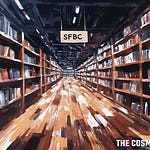My science fiction novelette “An Illicit Mercy” is part of a new promotion in August.
Over two hundred science fiction and fantasy novels, stories, samples, and excerpts available for download at no charge.
Science fiction, by its most rigorous definition, is fiction about science. It can be genuine science. Or it can be speculative science, based on our best understanding and theories.
Exceptions have existed from the beginning. The pulps abounded with imaginative technologies and abilities enjoying little scientific foundation. But the restrictions imposed by science distinguish science fiction from fantasy. As sf has grown, this prototypical form of the genre has become known as “hard science fiction”.
“[R]ocket ships that make U-turns”1, Heinlein pointed out, are fantastical. They're as fantastical as a flying horse (a topic he addresses in his short story “Jerry Was a Man”.) A fantasy author is free to make up whatever rules will suit their story. A hard sf author is not. They must have the knowledge to write within the confines of scientific fact and theory. They must have the talent to incorporate either into an interesting story.
A creeping obsolescence also threatens the ideas of hard sf authors.
Well-founded scientific speculation has the tendency to become fact. Less than 40 years ago, most of Neuromancer was science fiction. Today, cyberpunk is the sf subgenre most closely resembling our real world.
As soon as speculation in hard sf turns out to be wrong, the stories are out-of-date. In 1964, Roger Zelazny published his Hugo-nominated short story “A Rose for Ecclesiastes”. It's a tale of humans engaging with an alien Martian culture. Less than two years later, Mariner 4 revealed Mars to be a desolate wasteland. The Red Planet appears to be devoid of any sort of life.
Because of these factors, hard sf authors must stay informed of scientific advancements. This keeps their new stories grounded in current scientific fact. It also reveals fresh story possibilities based on cutting-edge scientific theory. Both provide the author with many opportunities to stretch their imagination.
We seem to be a long way from a complete understanding of our universe. Real and speculative science appear to be two wells unlikely to run dry.
Here are some of the greatest unsolved mysteries of science today:
What caused cosmic inflation?
We used to think our universe started with a Big Bang, which expanded from an initial singularity. But that doesn’t quite work.
Alone, the Big Bang theory doesn’t explain certain aspects of what we see today. Theorists have replaced the idea of an initial singularity with Cosmic Inflation theory. It posits the exponential expansion of the universe before the hot Big Bang.
Cosmic Inflation explains everything the Big Bang explains. It also explains a few phenomena the Big Bang can't. The good news is we no longer have to explain where the initial singularity came from. The bad news is we have no idea what caused Cosmic Inflation.
Is inflation eternal?
Cosmic Inflation doesn’t end in most models2. This implies eternal inflation. Space outside our universe continues the exponential expansion, forever.
Do we live in a multiverse?
If inflation does turn out to be eternal, this implies multiple universes. Over and over, inflation continues to end somewhere. Each instance results in a hot Big Bang. But inflation never ends everywhere. This means there will always be more hot Big Bangs—a multiverse.
But eternal inflation isn’t the only route to a multiverse. Theorists have identified four possible types. Could more than one type of multiverse coexist?
What is the nature of time?
We’re often taught to think of time as a fourth dimension. This is the “block universe”, predicted by special relativity. In the block universe, past, present, and future are all equally real. The present moment isn't distinctive. The “future” state of the universe develops from the "present" state in a deterministic fashion. Our impression that time passes is subjective. It's an illusion created by our minds’ perspectives of four-dimensional spacetime.
But not all theorists accept this definition. Relativity is at odds with quantum mechanics on precisely the issues of time and determinism.
How many dimensions make up our universe?
We “know” we live in a universe with three dimensions: length, breadth, and height. If we include time (see above), the number increases to four.
Believe it or not, we don’t know how many dimensions form our universe. Theories range up to ten and beyond.
How is gravity related to the three other fundamental forces?
General relativity gives us our current understanding of how gravity operates. Quantum mechanics does so for the electromagnetic, strong nuclear, and weak nuclear forces.
Unifying these two frameworks could yield the long-sought Theory of Everything, "...[explaining] and [linking] together all aspects of the universe."
Why don’t we see equal amounts of matter and antimatter in our universe?
Particle physics experiments have demonstrated creating matter entails creating an equal amount of antimatter.
We assume the Big Bang also should have created equal parts matter and antimatter. But then the two substances would have annihilated one another. This would have produced a universe containing nothing but radiation.
What caused the slight predominance of matter in our early universe, giving rise to us?
What is dark energy?
We don’t understand the nature of up to 75% of the mass-energy in our universe. This is the amount of energy—beyond what we detect with our current instruments—required to drive the accelerating rate at which the universe is expanding.
Most of our reality doesn’t consist of substances like those making up our world and ourselves. It consists of a mysterious something we can only infer from its effects.
What is dark matter?
Even if we restrict our inquiry to the material, we fare little better. We don’t understand the nature of more than 80% of the matter in our universe. Dark matter seems to interact with normal matter through gravity, but not electromagnetism. This would make it both invisible and intangible.
We owe our existence to something we can’t explain, and which we can only detect indirectly.
Is there life elsewhere in our universe?
Over sixty years ago, astronomer Frank Drake developed an equation “...to serve as the agenda for the first meeting on the topic of [the search for extraterrestrial intelligence].” Limited data makes it impossible to constrain most of the variables in the equation.
Estimates, based on the Drake equation, of the number of currently detectable civilizations in our galaxy extend from one (us) up to several million.
“Are we alone in the universe?” remains one of our most intractable questions.
How did life first begin on Earth?
Abiogenesis is the term for “…the natural process of life arising from non-living matter such as simple organic compounds.” Some researchers hypothesize life on Earth began as “self-replicating entities lacking metabolic functions or…metabolizing protocells that then developed the ability to self-replicate.” Others suggest life came to Earth from space via panspermia.
Right now, we don’t have the evidence to establish any theory as the best explanation for how life got started on Earth.
What is the nature of consciousness?
The phrase “the hard problem of consciousness” summarizes our search for “why and how humans…have…subjective experiences.” I know I am conscious. I have only circumstantial evidence and correlation that anyone else is conscious. Unlike other branches of science, the study of consciousness is subjective. This is why we have made very little progress in the scientific study of consciousness.
We have four leading theories of how consciousness arises from neural activity. Efforts to determine the best theory have so far proven inconclusive.
Solving the hard problem could give us insight into artificial intelligence, and ourselves. But we may need to create an entirely new form of science to do it.
Unanswered questions drive science forward. They are also the raw material for the stories of science fiction.
Robert A. Heinlein, Robert A. Heinlein’s Expanded Universe, Volume 2 (Phoenix Pick, an imprint of Arc Manor), 100
Max Tegmark, Our Mathematical Universe (Alfred A. Knopf, 2014), 111-2













Share this post